University Report: The One Belt One Road Initiative's Trade Impact
VerifiedAdded on 2023/04/25
|16
|4027
|455
Report
AI Summary
This report provides a comprehensive analysis of the One Belt One Road (OBOR) initiative, also known as the Belt and Road Initiative (BRI), spearheaded by the Chinese government. The report explores the initiative's two main divisions: the China-Pakistan Economic Corridor and the Bangladesh-China-India-Myanmar Corridor, emphasizing the latter's significance, particularly its inclusion of the Indian Ocean sea route. The analysis delves into the strategic and economic implications of OBOR, including its impact on global freight movement, China's economic growth, and its geopolitical influence. It examines the potential benefits, such as strengthened economies and easier movement of goods, and addresses operational challenges, including political tensions, security concerns, and taxation policies. The report also discusses key responses to the project from various countries and organizations, including India, the USA, and the EU, highlighting both support and opposition. Furthermore, the report includes figures and graphs illustrating global trade trends, GDP growth, and the OBOR map. Overall, the report offers a detailed overview of the OBOR initiative, its multifaceted impacts, and its implications for international trade and global dynamics.
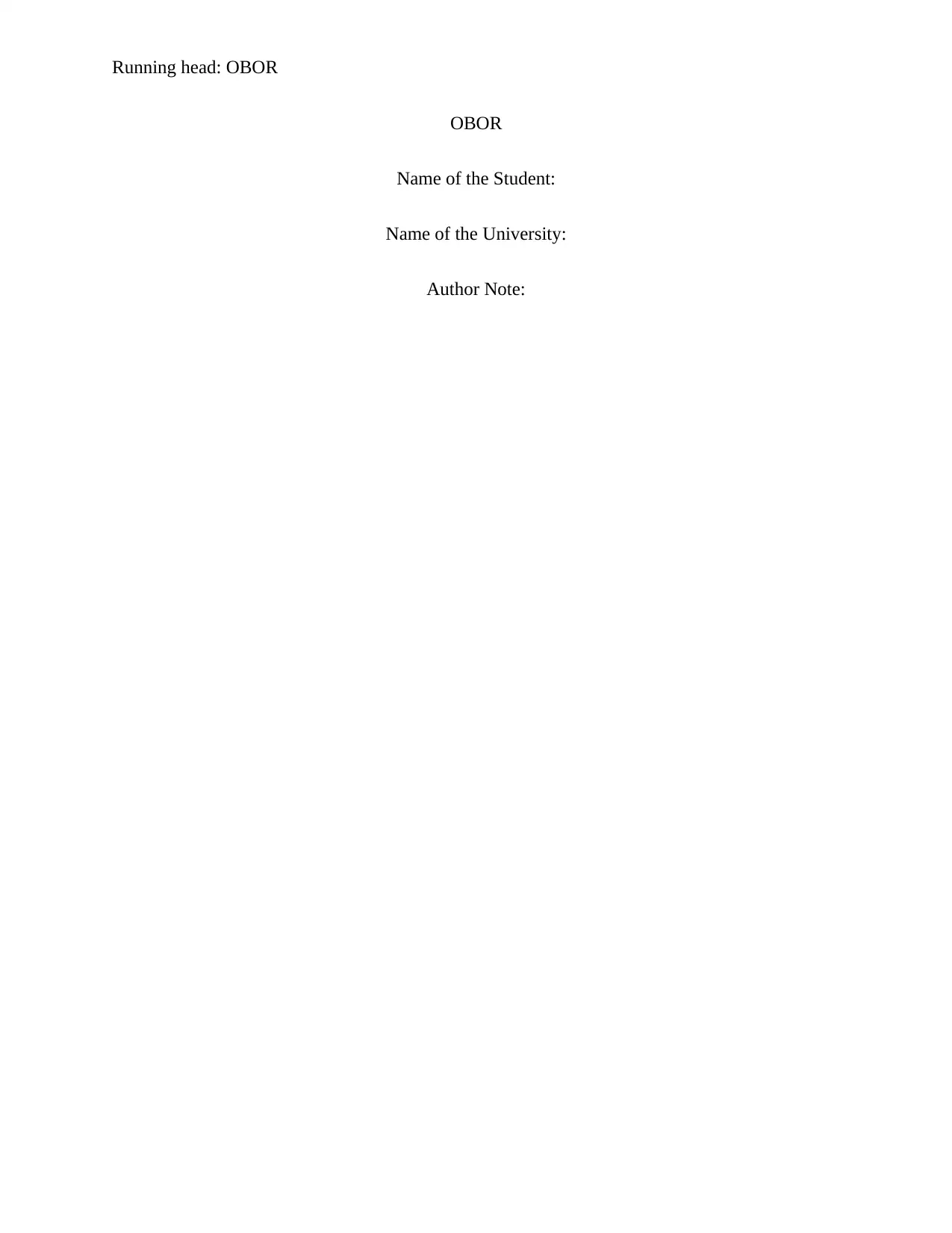
Running head: OBOR
OBOR
Name of the Student:
Name of the University:
Author Note:
OBOR
Name of the Student:
Name of the University:
Author Note:
Paraphrase This Document
Need a fresh take? Get an instant paraphrase of this document with our AI Paraphraser
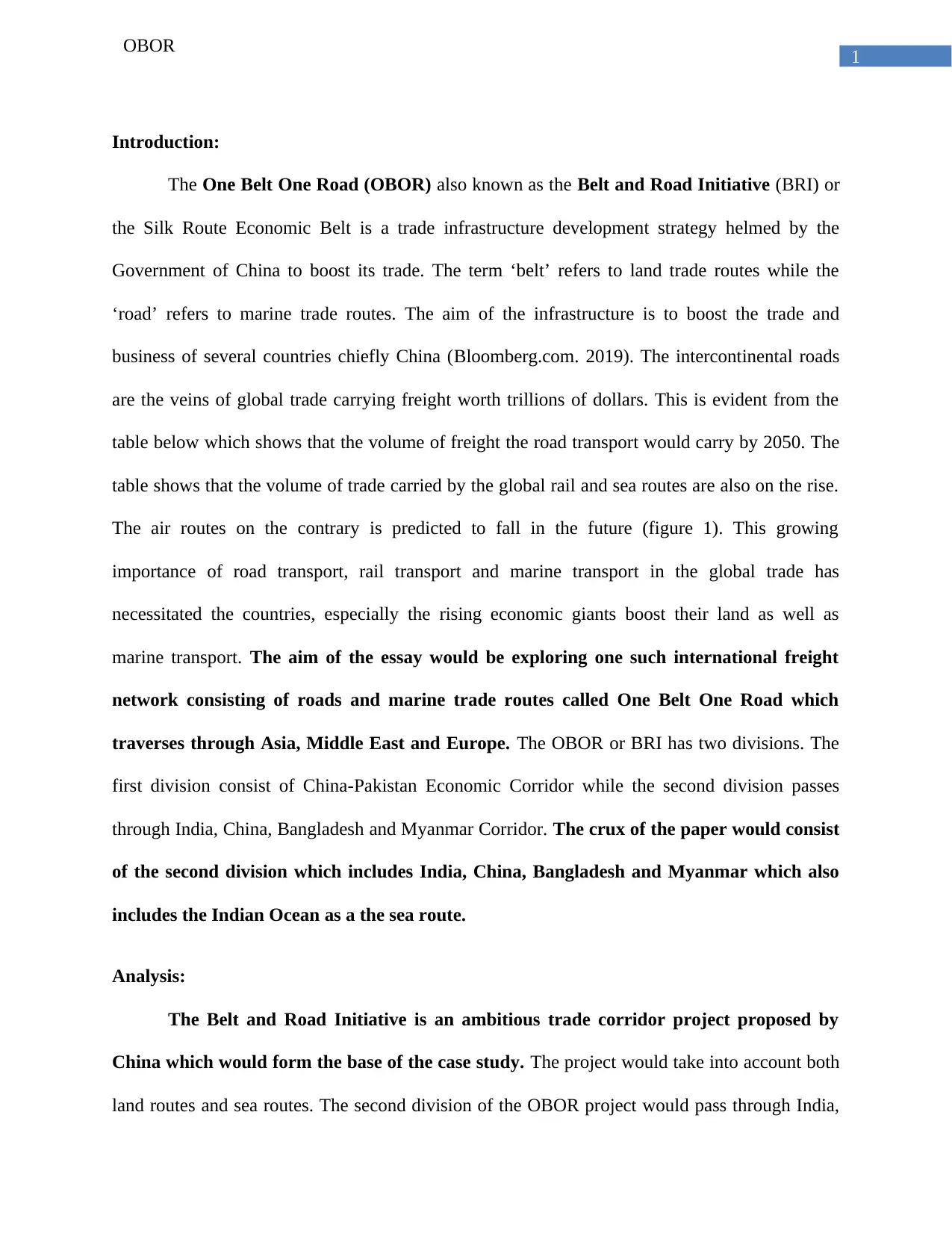
1
OBOR
Introduction:
The One Belt One Road (OBOR) also known as the Belt and Road Initiative (BRI) or
the Silk Route Economic Belt is a trade infrastructure development strategy helmed by the
Government of China to boost its trade. The term ‘belt’ refers to land trade routes while the
‘road’ refers to marine trade routes. The aim of the infrastructure is to boost the trade and
business of several countries chiefly China (Bloomberg.com. 2019). The intercontinental roads
are the veins of global trade carrying freight worth trillions of dollars. This is evident from the
table below which shows that the volume of freight the road transport would carry by 2050. The
table shows that the volume of trade carried by the global rail and sea routes are also on the rise.
The air routes on the contrary is predicted to fall in the future (figure 1). This growing
importance of road transport, rail transport and marine transport in the global trade has
necessitated the countries, especially the rising economic giants boost their land as well as
marine transport. The aim of the essay would be exploring one such international freight
network consisting of roads and marine trade routes called One Belt One Road which
traverses through Asia, Middle East and Europe. The OBOR or BRI has two divisions. The
first division consist of China-Pakistan Economic Corridor while the second division passes
through India, China, Bangladesh and Myanmar Corridor. The crux of the paper would consist
of the second division which includes India, China, Bangladesh and Myanmar which also
includes the Indian Ocean as a the sea route.
Analysis:
The Belt and Road Initiative is an ambitious trade corridor project proposed by
China which would form the base of the case study. The project would take into account both
land routes and sea routes. The second division of the OBOR project would pass through India,
OBOR
Introduction:
The One Belt One Road (OBOR) also known as the Belt and Road Initiative (BRI) or
the Silk Route Economic Belt is a trade infrastructure development strategy helmed by the
Government of China to boost its trade. The term ‘belt’ refers to land trade routes while the
‘road’ refers to marine trade routes. The aim of the infrastructure is to boost the trade and
business of several countries chiefly China (Bloomberg.com. 2019). The intercontinental roads
are the veins of global trade carrying freight worth trillions of dollars. This is evident from the
table below which shows that the volume of freight the road transport would carry by 2050. The
table shows that the volume of trade carried by the global rail and sea routes are also on the rise.
The air routes on the contrary is predicted to fall in the future (figure 1). This growing
importance of road transport, rail transport and marine transport in the global trade has
necessitated the countries, especially the rising economic giants boost their land as well as
marine transport. The aim of the essay would be exploring one such international freight
network consisting of roads and marine trade routes called One Belt One Road which
traverses through Asia, Middle East and Europe. The OBOR or BRI has two divisions. The
first division consist of China-Pakistan Economic Corridor while the second division passes
through India, China, Bangladesh and Myanmar Corridor. The crux of the paper would consist
of the second division which includes India, China, Bangladesh and Myanmar which also
includes the Indian Ocean as a the sea route.
Analysis:
The Belt and Road Initiative is an ambitious trade corridor project proposed by
China which would form the base of the case study. The project would take into account both
land routes and sea routes. The second division of the OBOR project would pass through India,
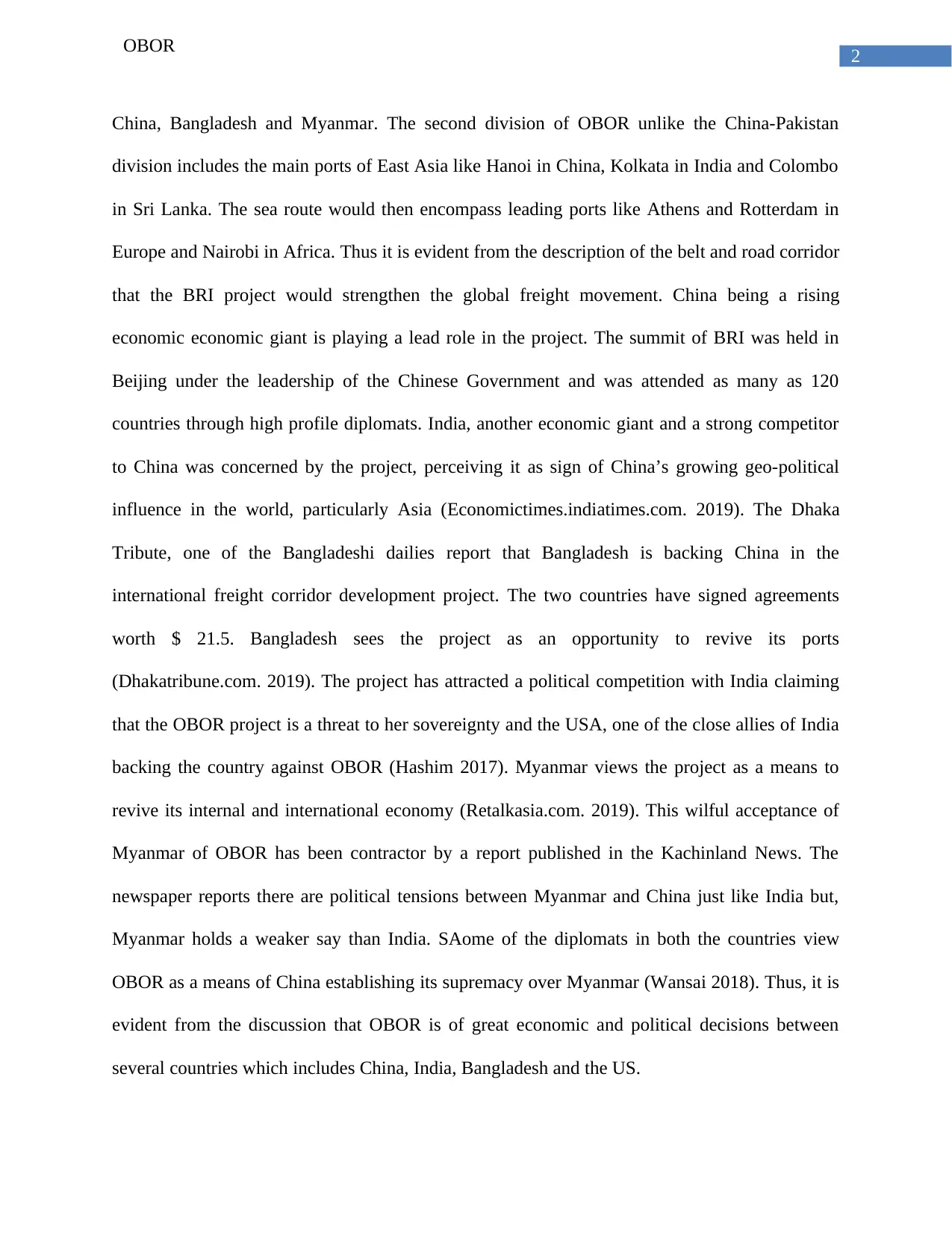
2
OBOR
China, Bangladesh and Myanmar. The second division of OBOR unlike the China-Pakistan
division includes the main ports of East Asia like Hanoi in China, Kolkata in India and Colombo
in Sri Lanka. The sea route would then encompass leading ports like Athens and Rotterdam in
Europe and Nairobi in Africa. Thus it is evident from the description of the belt and road corridor
that the BRI project would strengthen the global freight movement. China being a rising
economic economic giant is playing a lead role in the project. The summit of BRI was held in
Beijing under the leadership of the Chinese Government and was attended as many as 120
countries through high profile diplomats. India, another economic giant and a strong competitor
to China was concerned by the project, perceiving it as sign of China’s growing geo-political
influence in the world, particularly Asia (Economictimes.indiatimes.com. 2019). The Dhaka
Tribute, one of the Bangladeshi dailies report that Bangladesh is backing China in the
international freight corridor development project. The two countries have signed agreements
worth $ 21.5. Bangladesh sees the project as an opportunity to revive its ports
(Dhakatribune.com. 2019). The project has attracted a political competition with India claiming
that the OBOR project is a threat to her sovereignty and the USA, one of the close allies of India
backing the country against OBOR (Hashim 2017). Myanmar views the project as a means to
revive its internal and international economy (Retalkasia.com. 2019). This wilful acceptance of
Myanmar of OBOR has been contractor by a report published in the Kachinland News. The
newspaper reports there are political tensions between Myanmar and China just like India but,
Myanmar holds a weaker say than India. SAome of the diplomats in both the countries view
OBOR as a means of China establishing its supremacy over Myanmar (Wansai 2018). Thus, it is
evident from the discussion that OBOR is of great economic and political decisions between
several countries which includes China, India, Bangladesh and the US.
OBOR
China, Bangladesh and Myanmar. The second division of OBOR unlike the China-Pakistan
division includes the main ports of East Asia like Hanoi in China, Kolkata in India and Colombo
in Sri Lanka. The sea route would then encompass leading ports like Athens and Rotterdam in
Europe and Nairobi in Africa. Thus it is evident from the description of the belt and road corridor
that the BRI project would strengthen the global freight movement. China being a rising
economic economic giant is playing a lead role in the project. The summit of BRI was held in
Beijing under the leadership of the Chinese Government and was attended as many as 120
countries through high profile diplomats. India, another economic giant and a strong competitor
to China was concerned by the project, perceiving it as sign of China’s growing geo-political
influence in the world, particularly Asia (Economictimes.indiatimes.com. 2019). The Dhaka
Tribute, one of the Bangladeshi dailies report that Bangladesh is backing China in the
international freight corridor development project. The two countries have signed agreements
worth $ 21.5. Bangladesh sees the project as an opportunity to revive its ports
(Dhakatribune.com. 2019). The project has attracted a political competition with India claiming
that the OBOR project is a threat to her sovereignty and the USA, one of the close allies of India
backing the country against OBOR (Hashim 2017). Myanmar views the project as a means to
revive its internal and international economy (Retalkasia.com. 2019). This wilful acceptance of
Myanmar of OBOR has been contractor by a report published in the Kachinland News. The
newspaper reports there are political tensions between Myanmar and China just like India but,
Myanmar holds a weaker say than India. SAome of the diplomats in both the countries view
OBOR as a means of China establishing its supremacy over Myanmar (Wansai 2018). Thus, it is
evident from the discussion that OBOR is of great economic and political decisions between
several countries which includes China, India, Bangladesh and the US.
⊘ This is a preview!⊘
Do you want full access?
Subscribe today to unlock all pages.

Trusted by 1+ million students worldwide
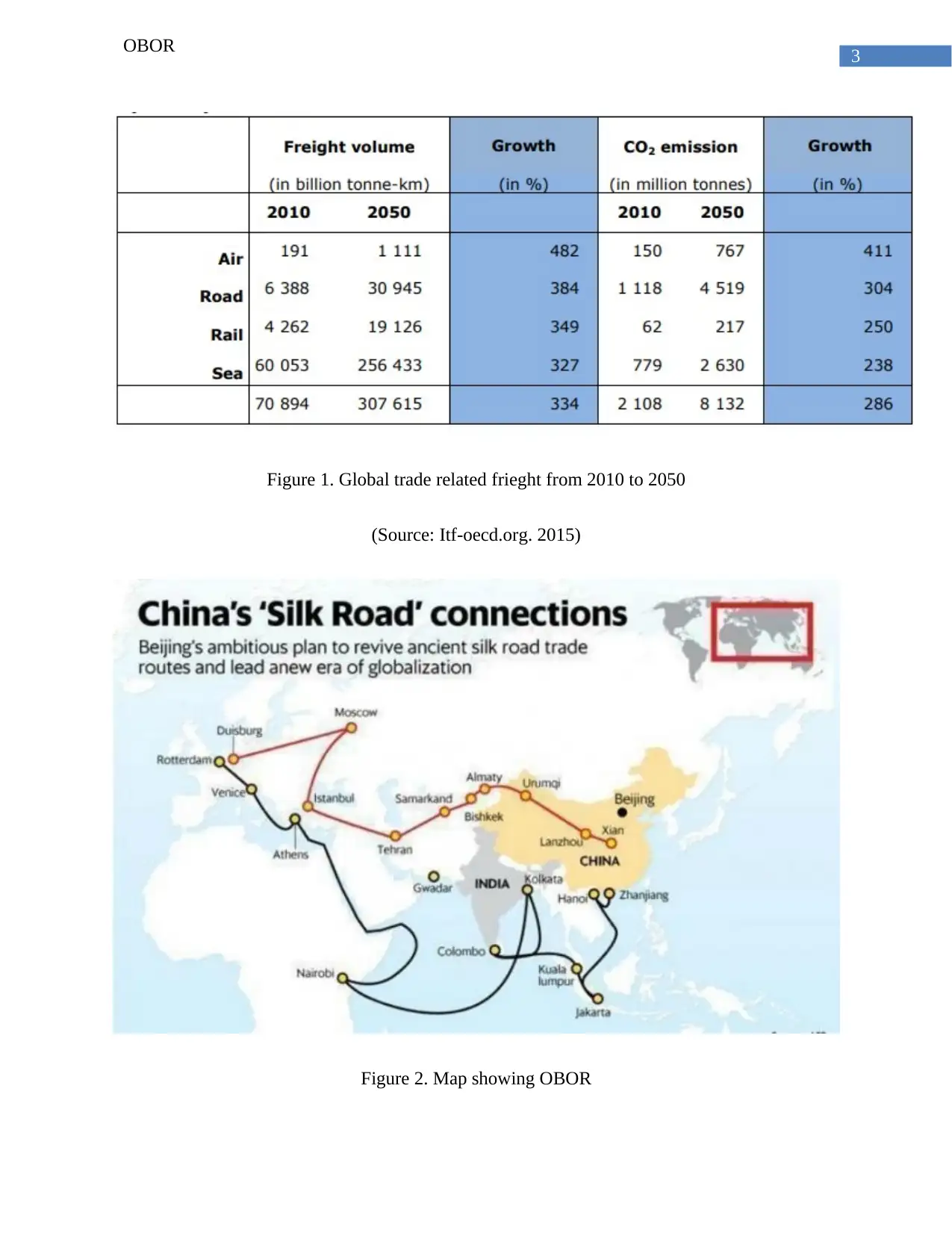
3
OBOR
Figure 1. Global trade related frieght from 2010 to 2050
(Source: Itf-oecd.org. 2015)
Figure 2. Map showing OBOR
OBOR
Figure 1. Global trade related frieght from 2010 to 2050
(Source: Itf-oecd.org. 2015)
Figure 2. Map showing OBOR
Paraphrase This Document
Need a fresh take? Get an instant paraphrase of this document with our AI Paraphraser
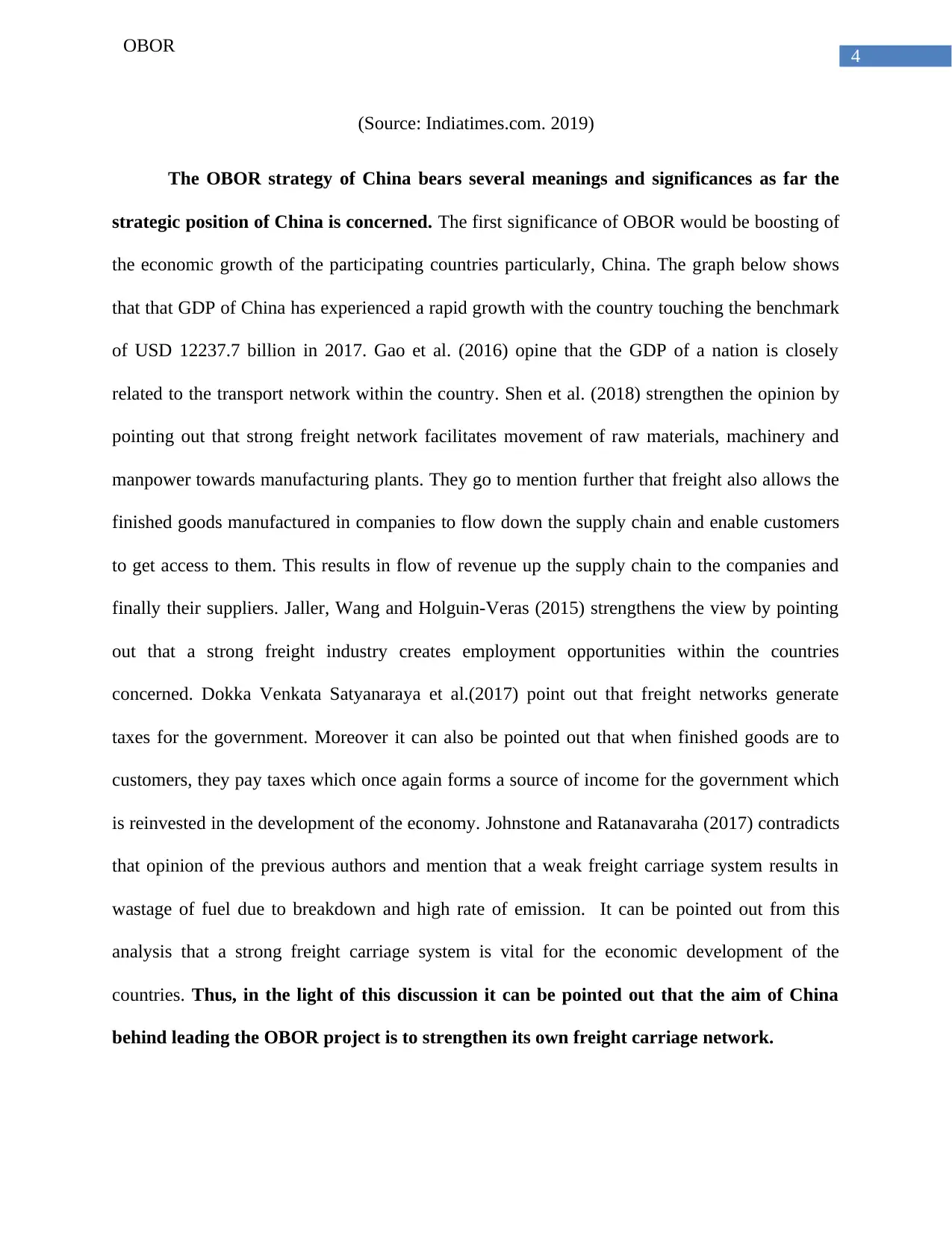
4
OBOR
(Source: Indiatimes.com. 2019)
The OBOR strategy of China bears several meanings and significances as far the
strategic position of China is concerned. The first significance of OBOR would be boosting of
the economic growth of the participating countries particularly, China. The graph below shows
that that GDP of China has experienced a rapid growth with the country touching the benchmark
of USD 12237.7 billion in 2017. Gao et al. (2016) opine that the GDP of a nation is closely
related to the transport network within the country. Shen et al. (2018) strengthen the opinion by
pointing out that strong freight network facilitates movement of raw materials, machinery and
manpower towards manufacturing plants. They go to mention further that freight also allows the
finished goods manufactured in companies to flow down the supply chain and enable customers
to get access to them. This results in flow of revenue up the supply chain to the companies and
finally their suppliers. Jaller, Wang and Holguin-Veras (2015) strengthens the view by pointing
out that a strong freight industry creates employment opportunities within the countries
concerned. Dokka Venkata Satyanaraya et al.(2017) point out that freight networks generate
taxes for the government. Moreover it can also be pointed out that when finished goods are to
customers, they pay taxes which once again forms a source of income for the government which
is reinvested in the development of the economy. Johnstone and Ratanavaraha (2017) contradicts
that opinion of the previous authors and mention that a weak freight carriage system results in
wastage of fuel due to breakdown and high rate of emission. It can be pointed out from this
analysis that a strong freight carriage system is vital for the economic development of the
countries. Thus, in the light of this discussion it can be pointed out that the aim of China
behind leading the OBOR project is to strengthen its own freight carriage network.
OBOR
(Source: Indiatimes.com. 2019)
The OBOR strategy of China bears several meanings and significances as far the
strategic position of China is concerned. The first significance of OBOR would be boosting of
the economic growth of the participating countries particularly, China. The graph below shows
that that GDP of China has experienced a rapid growth with the country touching the benchmark
of USD 12237.7 billion in 2017. Gao et al. (2016) opine that the GDP of a nation is closely
related to the transport network within the country. Shen et al. (2018) strengthen the opinion by
pointing out that strong freight network facilitates movement of raw materials, machinery and
manpower towards manufacturing plants. They go to mention further that freight also allows the
finished goods manufactured in companies to flow down the supply chain and enable customers
to get access to them. This results in flow of revenue up the supply chain to the companies and
finally their suppliers. Jaller, Wang and Holguin-Veras (2015) strengthens the view by pointing
out that a strong freight industry creates employment opportunities within the countries
concerned. Dokka Venkata Satyanaraya et al.(2017) point out that freight networks generate
taxes for the government. Moreover it can also be pointed out that when finished goods are to
customers, they pay taxes which once again forms a source of income for the government which
is reinvested in the development of the economy. Johnstone and Ratanavaraha (2017) contradicts
that opinion of the previous authors and mention that a weak freight carriage system results in
wastage of fuel due to breakdown and high rate of emission. It can be pointed out from this
analysis that a strong freight carriage system is vital for the economic development of the
countries. Thus, in the light of this discussion it can be pointed out that the aim of China
behind leading the OBOR project is to strengthen its own freight carriage network.
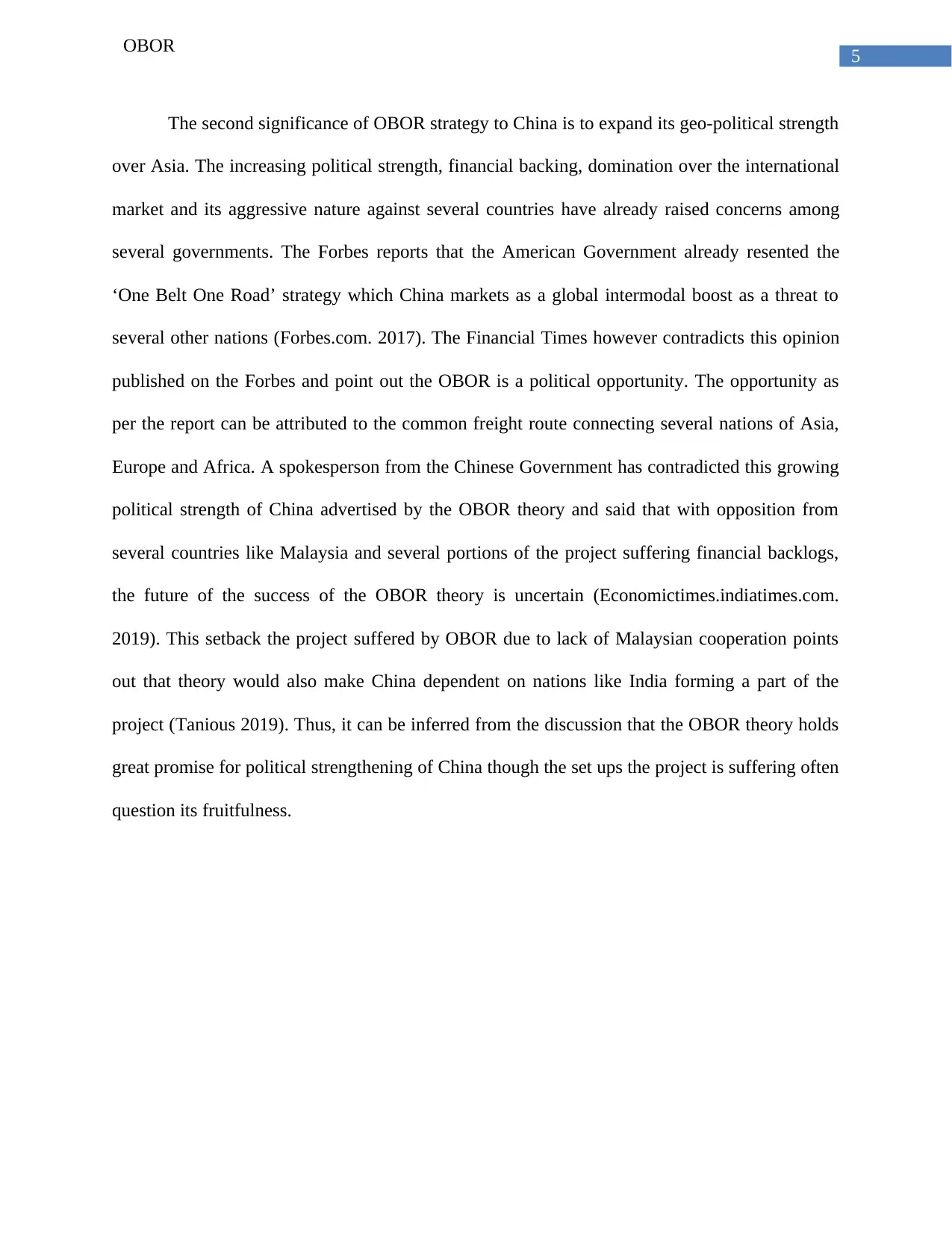
5
OBOR
The second significance of OBOR strategy to China is to expand its geo-political strength
over Asia. The increasing political strength, financial backing, domination over the international
market and its aggressive nature against several countries have already raised concerns among
several governments. The Forbes reports that the American Government already resented the
‘One Belt One Road’ strategy which China markets as a global intermodal boost as a threat to
several other nations (Forbes.com. 2017). The Financial Times however contradicts this opinion
published on the Forbes and point out the OBOR is a political opportunity. The opportunity as
per the report can be attributed to the common freight route connecting several nations of Asia,
Europe and Africa. A spokesperson from the Chinese Government has contradicted this growing
political strength of China advertised by the OBOR theory and said that with opposition from
several countries like Malaysia and several portions of the project suffering financial backlogs,
the future of the success of the OBOR theory is uncertain (Economictimes.indiatimes.com.
2019). This setback the project suffered by OBOR due to lack of Malaysian cooperation points
out that theory would also make China dependent on nations like India forming a part of the
project (Tanious 2019). Thus, it can be inferred from the discussion that the OBOR theory holds
great promise for political strengthening of China though the set ups the project is suffering often
question its fruitfulness.
OBOR
The second significance of OBOR strategy to China is to expand its geo-political strength
over Asia. The increasing political strength, financial backing, domination over the international
market and its aggressive nature against several countries have already raised concerns among
several governments. The Forbes reports that the American Government already resented the
‘One Belt One Road’ strategy which China markets as a global intermodal boost as a threat to
several other nations (Forbes.com. 2017). The Financial Times however contradicts this opinion
published on the Forbes and point out the OBOR is a political opportunity. The opportunity as
per the report can be attributed to the common freight route connecting several nations of Asia,
Europe and Africa. A spokesperson from the Chinese Government has contradicted this growing
political strength of China advertised by the OBOR theory and said that with opposition from
several countries like Malaysia and several portions of the project suffering financial backlogs,
the future of the success of the OBOR theory is uncertain (Economictimes.indiatimes.com.
2019). This setback the project suffered by OBOR due to lack of Malaysian cooperation points
out that theory would also make China dependent on nations like India forming a part of the
project (Tanious 2019). Thus, it can be inferred from the discussion that the OBOR theory holds
great promise for political strengthening of China though the set ups the project is suffering often
question its fruitfulness.
⊘ This is a preview!⊘
Do you want full access?
Subscribe today to unlock all pages.

Trusted by 1+ million students worldwide
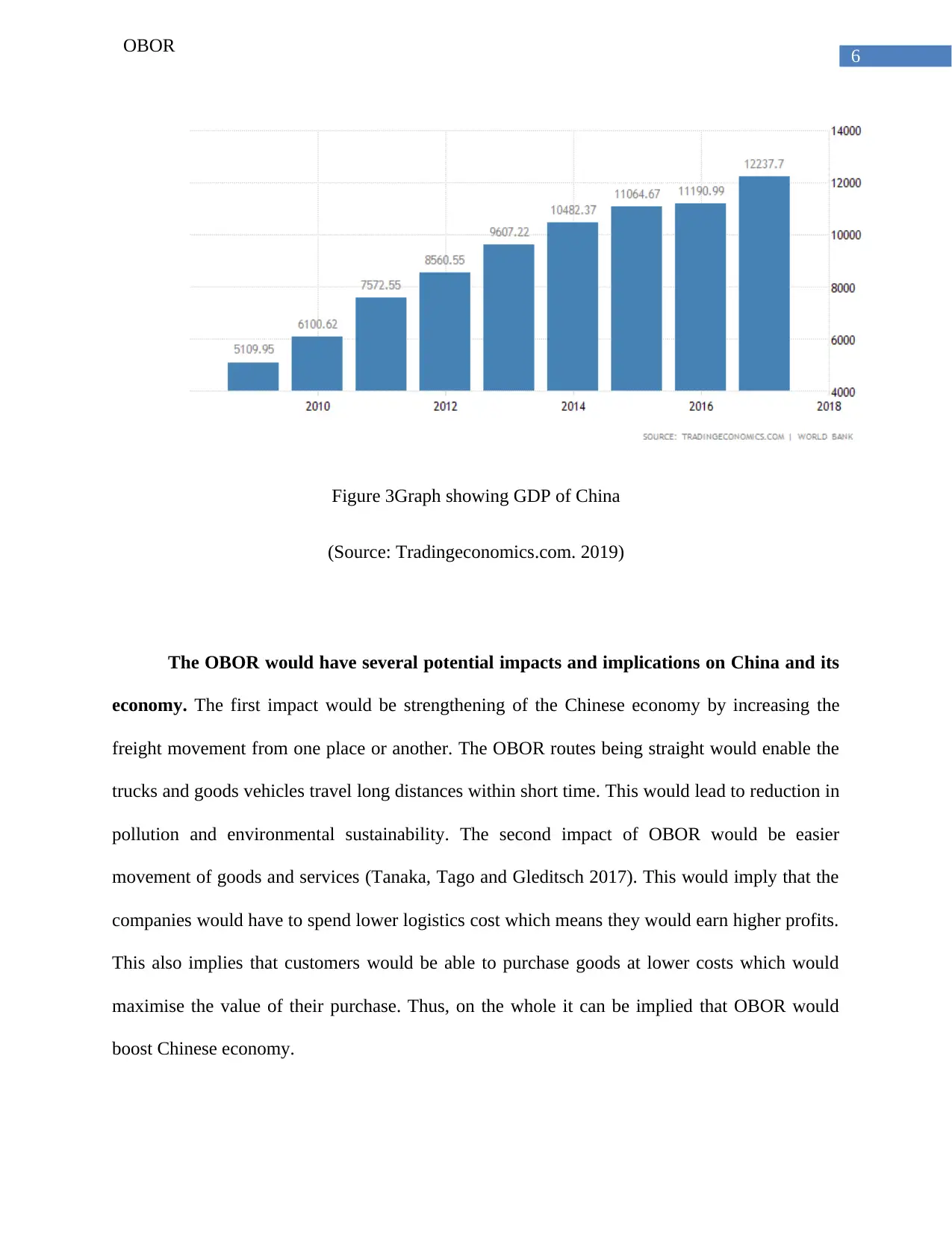
6
OBOR
Figure 3Graph showing GDP of China
(Source: Tradingeconomics.com. 2019)
The OBOR would have several potential impacts and implications on China and its
economy. The first impact would be strengthening of the Chinese economy by increasing the
freight movement from one place or another. The OBOR routes being straight would enable the
trucks and goods vehicles travel long distances within short time. This would lead to reduction in
pollution and environmental sustainability. The second impact of OBOR would be easier
movement of goods and services (Tanaka, Tago and Gleditsch 2017). This would imply that the
companies would have to spend lower logistics cost which means they would earn higher profits.
This also implies that customers would be able to purchase goods at lower costs which would
maximise the value of their purchase. Thus, on the whole it can be implied that OBOR would
boost Chinese economy.
OBOR
Figure 3Graph showing GDP of China
(Source: Tradingeconomics.com. 2019)
The OBOR would have several potential impacts and implications on China and its
economy. The first impact would be strengthening of the Chinese economy by increasing the
freight movement from one place or another. The OBOR routes being straight would enable the
trucks and goods vehicles travel long distances within short time. This would lead to reduction in
pollution and environmental sustainability. The second impact of OBOR would be easier
movement of goods and services (Tanaka, Tago and Gleditsch 2017). This would imply that the
companies would have to spend lower logistics cost which means they would earn higher profits.
This also implies that customers would be able to purchase goods at lower costs which would
maximise the value of their purchase. Thus, on the whole it can be implied that OBOR would
boost Chinese economy.
Paraphrase This Document
Need a fresh take? Get an instant paraphrase of this document with our AI Paraphraser
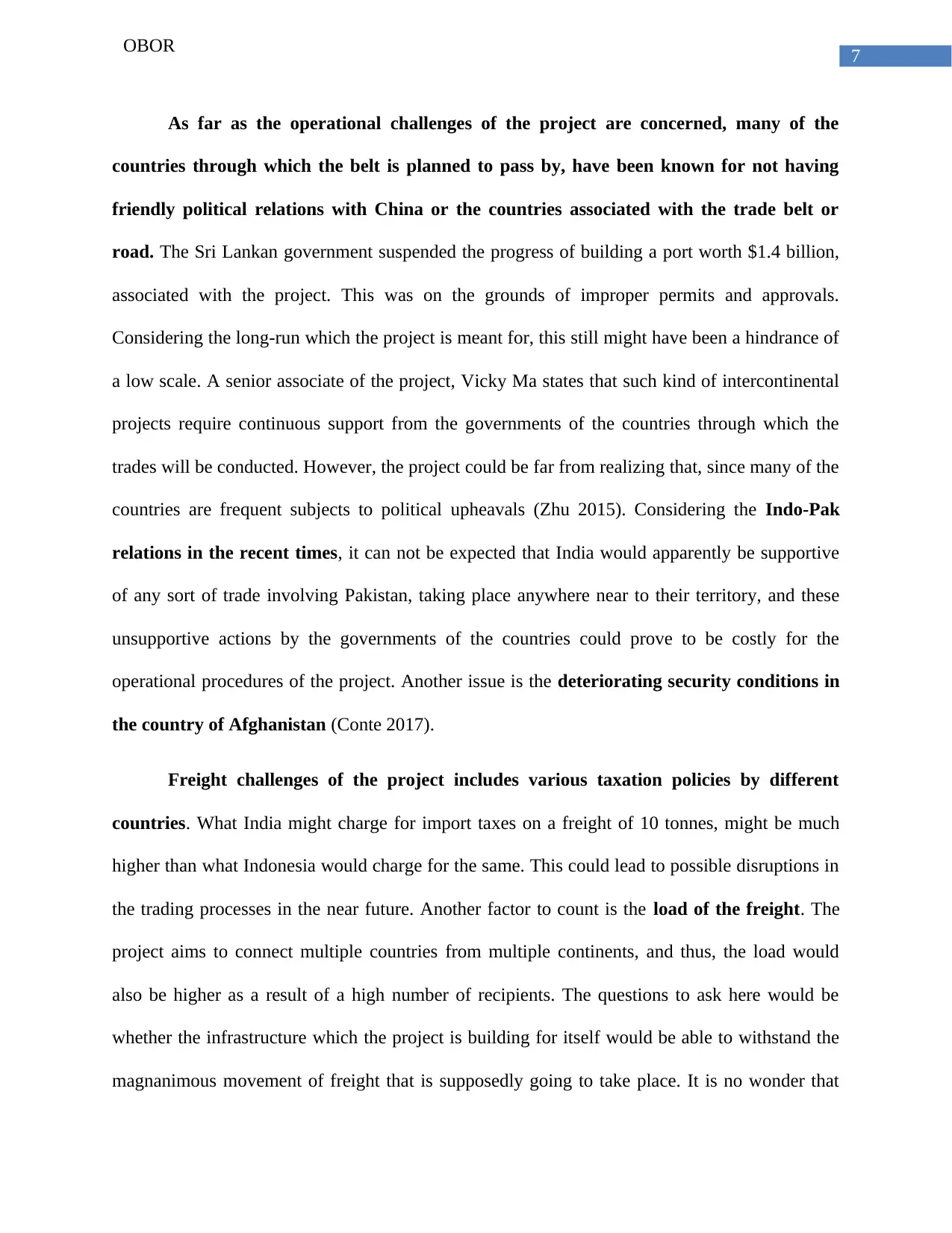
7
OBOR
As far as the operational challenges of the project are concerned, many of the
countries through which the belt is planned to pass by, have been known for not having
friendly political relations with China or the countries associated with the trade belt or
road. The Sri Lankan government suspended the progress of building a port worth $1.4 billion,
associated with the project. This was on the grounds of improper permits and approvals.
Considering the long-run which the project is meant for, this still might have been a hindrance of
a low scale. A senior associate of the project, Vicky Ma states that such kind of intercontinental
projects require continuous support from the governments of the countries through which the
trades will be conducted. However, the project could be far from realizing that, since many of the
countries are frequent subjects to political upheavals (Zhu 2015). Considering the Indo-Pak
relations in the recent times, it can not be expected that India would apparently be supportive
of any sort of trade involving Pakistan, taking place anywhere near to their territory, and these
unsupportive actions by the governments of the countries could prove to be costly for the
operational procedures of the project. Another issue is the deteriorating security conditions in
the country of Afghanistan (Conte 2017).
Freight challenges of the project includes various taxation policies by different
countries. What India might charge for import taxes on a freight of 10 tonnes, might be much
higher than what Indonesia would charge for the same. This could lead to possible disruptions in
the trading processes in the near future. Another factor to count is the load of the freight. The
project aims to connect multiple countries from multiple continents, and thus, the load would
also be higher as a result of a high number of recipients. The questions to ask here would be
whether the infrastructure which the project is building for itself would be able to withstand the
magnanimous movement of freight that is supposedly going to take place. It is no wonder that
OBOR
As far as the operational challenges of the project are concerned, many of the
countries through which the belt is planned to pass by, have been known for not having
friendly political relations with China or the countries associated with the trade belt or
road. The Sri Lankan government suspended the progress of building a port worth $1.4 billion,
associated with the project. This was on the grounds of improper permits and approvals.
Considering the long-run which the project is meant for, this still might have been a hindrance of
a low scale. A senior associate of the project, Vicky Ma states that such kind of intercontinental
projects require continuous support from the governments of the countries through which the
trades will be conducted. However, the project could be far from realizing that, since many of the
countries are frequent subjects to political upheavals (Zhu 2015). Considering the Indo-Pak
relations in the recent times, it can not be expected that India would apparently be supportive
of any sort of trade involving Pakistan, taking place anywhere near to their territory, and these
unsupportive actions by the governments of the countries could prove to be costly for the
operational procedures of the project. Another issue is the deteriorating security conditions in
the country of Afghanistan (Conte 2017).
Freight challenges of the project includes various taxation policies by different
countries. What India might charge for import taxes on a freight of 10 tonnes, might be much
higher than what Indonesia would charge for the same. This could lead to possible disruptions in
the trading processes in the near future. Another factor to count is the load of the freight. The
project aims to connect multiple countries from multiple continents, and thus, the load would
also be higher as a result of a high number of recipients. The questions to ask here would be
whether the infrastructure which the project is building for itself would be able to withstand the
magnanimous movement of freight that is supposedly going to take place. It is no wonder that
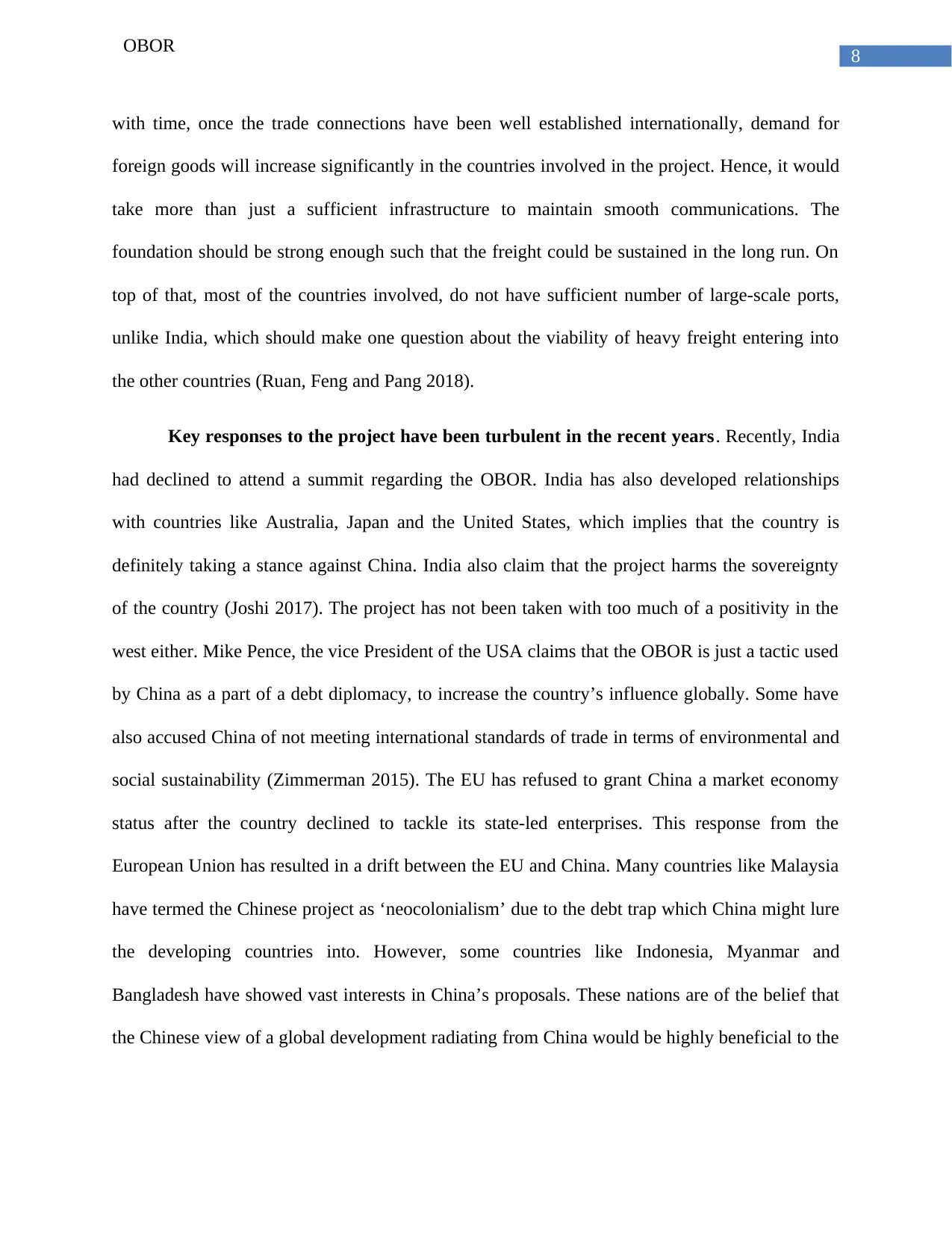
8
OBOR
with time, once the trade connections have been well established internationally, demand for
foreign goods will increase significantly in the countries involved in the project. Hence, it would
take more than just a sufficient infrastructure to maintain smooth communications. The
foundation should be strong enough such that the freight could be sustained in the long run. On
top of that, most of the countries involved, do not have sufficient number of large-scale ports,
unlike India, which should make one question about the viability of heavy freight entering into
the other countries (Ruan, Feng and Pang 2018).
Key responses to the project have been turbulent in the recent years. Recently, India
had declined to attend a summit regarding the OBOR. India has also developed relationships
with countries like Australia, Japan and the United States, which implies that the country is
definitely taking a stance against China. India also claim that the project harms the sovereignty
of the country (Joshi 2017). The project has not been taken with too much of a positivity in the
west either. Mike Pence, the vice President of the USA claims that the OBOR is just a tactic used
by China as a part of a debt diplomacy, to increase the country’s influence globally. Some have
also accused China of not meeting international standards of trade in terms of environmental and
social sustainability (Zimmerman 2015). The EU has refused to grant China a market economy
status after the country declined to tackle its state-led enterprises. This response from the
European Union has resulted in a drift between the EU and China. Many countries like Malaysia
have termed the Chinese project as ‘neocolonialism’ due to the debt trap which China might lure
the developing countries into. However, some countries like Indonesia, Myanmar and
Bangladesh have showed vast interests in China’s proposals. These nations are of the belief that
the Chinese view of a global development radiating from China would be highly beneficial to the
OBOR
with time, once the trade connections have been well established internationally, demand for
foreign goods will increase significantly in the countries involved in the project. Hence, it would
take more than just a sufficient infrastructure to maintain smooth communications. The
foundation should be strong enough such that the freight could be sustained in the long run. On
top of that, most of the countries involved, do not have sufficient number of large-scale ports,
unlike India, which should make one question about the viability of heavy freight entering into
the other countries (Ruan, Feng and Pang 2018).
Key responses to the project have been turbulent in the recent years. Recently, India
had declined to attend a summit regarding the OBOR. India has also developed relationships
with countries like Australia, Japan and the United States, which implies that the country is
definitely taking a stance against China. India also claim that the project harms the sovereignty
of the country (Joshi 2017). The project has not been taken with too much of a positivity in the
west either. Mike Pence, the vice President of the USA claims that the OBOR is just a tactic used
by China as a part of a debt diplomacy, to increase the country’s influence globally. Some have
also accused China of not meeting international standards of trade in terms of environmental and
social sustainability (Zimmerman 2015). The EU has refused to grant China a market economy
status after the country declined to tackle its state-led enterprises. This response from the
European Union has resulted in a drift between the EU and China. Many countries like Malaysia
have termed the Chinese project as ‘neocolonialism’ due to the debt trap which China might lure
the developing countries into. However, some countries like Indonesia, Myanmar and
Bangladesh have showed vast interests in China’s proposals. These nations are of the belief that
the Chinese view of a global development radiating from China would be highly beneficial to the
⊘ This is a preview!⊘
Do you want full access?
Subscribe today to unlock all pages.

Trusted by 1+ million students worldwide
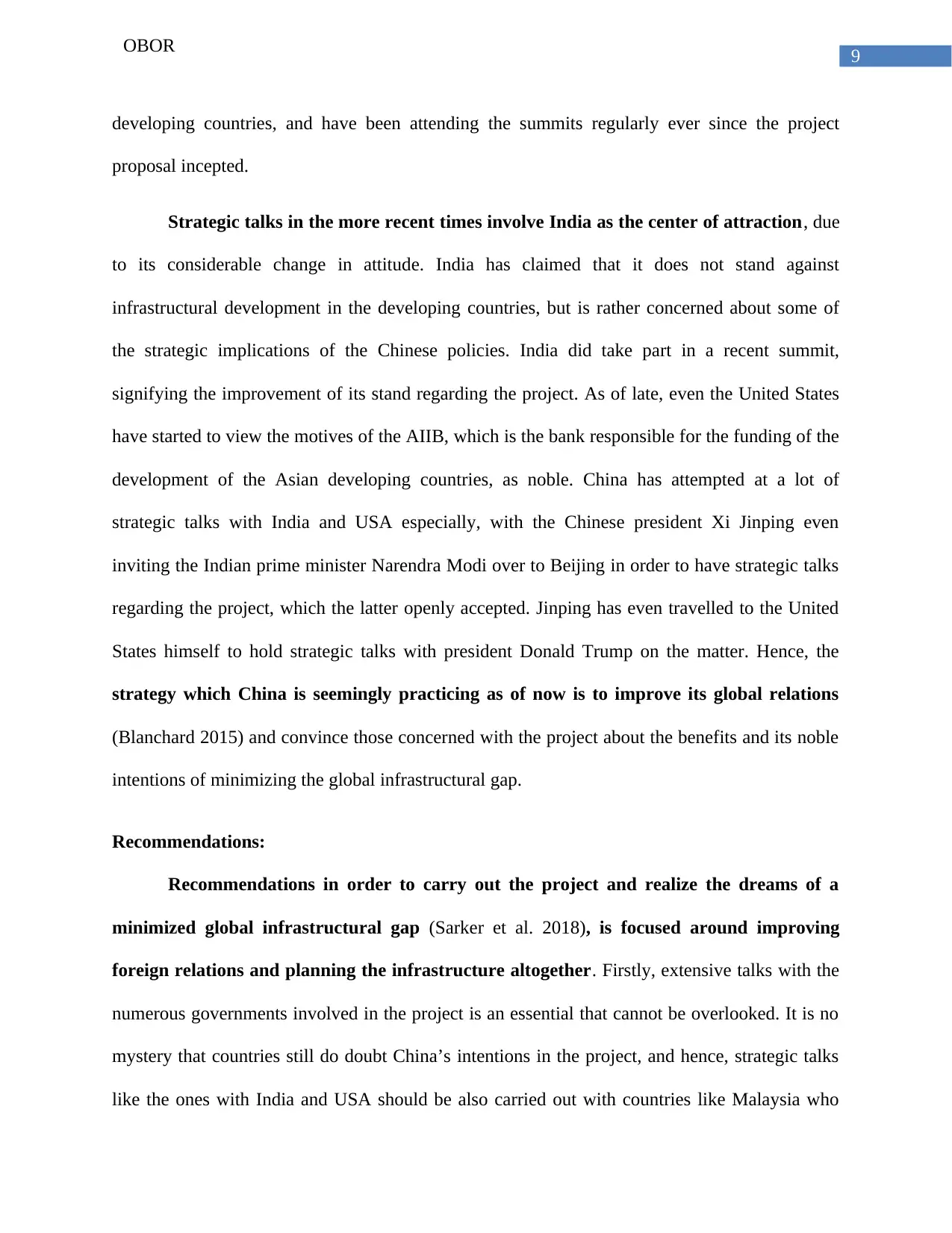
9
OBOR
developing countries, and have been attending the summits regularly ever since the project
proposal incepted.
Strategic talks in the more recent times involve India as the center of attraction, due
to its considerable change in attitude. India has claimed that it does not stand against
infrastructural development in the developing countries, but is rather concerned about some of
the strategic implications of the Chinese policies. India did take part in a recent summit,
signifying the improvement of its stand regarding the project. As of late, even the United States
have started to view the motives of the AIIB, which is the bank responsible for the funding of the
development of the Asian developing countries, as noble. China has attempted at a lot of
strategic talks with India and USA especially, with the Chinese president Xi Jinping even
inviting the Indian prime minister Narendra Modi over to Beijing in order to have strategic talks
regarding the project, which the latter openly accepted. Jinping has even travelled to the United
States himself to hold strategic talks with president Donald Trump on the matter. Hence, the
strategy which China is seemingly practicing as of now is to improve its global relations
(Blanchard 2015) and convince those concerned with the project about the benefits and its noble
intentions of minimizing the global infrastructural gap.
Recommendations:
Recommendations in order to carry out the project and realize the dreams of a
minimized global infrastructural gap (Sarker et al. 2018), is focused around improving
foreign relations and planning the infrastructure altogether. Firstly, extensive talks with the
numerous governments involved in the project is an essential that cannot be overlooked. It is no
mystery that countries still do doubt China’s intentions in the project, and hence, strategic talks
like the ones with India and USA should be also carried out with countries like Malaysia who
OBOR
developing countries, and have been attending the summits regularly ever since the project
proposal incepted.
Strategic talks in the more recent times involve India as the center of attraction, due
to its considerable change in attitude. India has claimed that it does not stand against
infrastructural development in the developing countries, but is rather concerned about some of
the strategic implications of the Chinese policies. India did take part in a recent summit,
signifying the improvement of its stand regarding the project. As of late, even the United States
have started to view the motives of the AIIB, which is the bank responsible for the funding of the
development of the Asian developing countries, as noble. China has attempted at a lot of
strategic talks with India and USA especially, with the Chinese president Xi Jinping even
inviting the Indian prime minister Narendra Modi over to Beijing in order to have strategic talks
regarding the project, which the latter openly accepted. Jinping has even travelled to the United
States himself to hold strategic talks with president Donald Trump on the matter. Hence, the
strategy which China is seemingly practicing as of now is to improve its global relations
(Blanchard 2015) and convince those concerned with the project about the benefits and its noble
intentions of minimizing the global infrastructural gap.
Recommendations:
Recommendations in order to carry out the project and realize the dreams of a
minimized global infrastructural gap (Sarker et al. 2018), is focused around improving
foreign relations and planning the infrastructure altogether. Firstly, extensive talks with the
numerous governments involved in the project is an essential that cannot be overlooked. It is no
mystery that countries still do doubt China’s intentions in the project, and hence, strategic talks
like the ones with India and USA should be also carried out with countries like Malaysia who
Paraphrase This Document
Need a fresh take? Get an instant paraphrase of this document with our AI Paraphraser
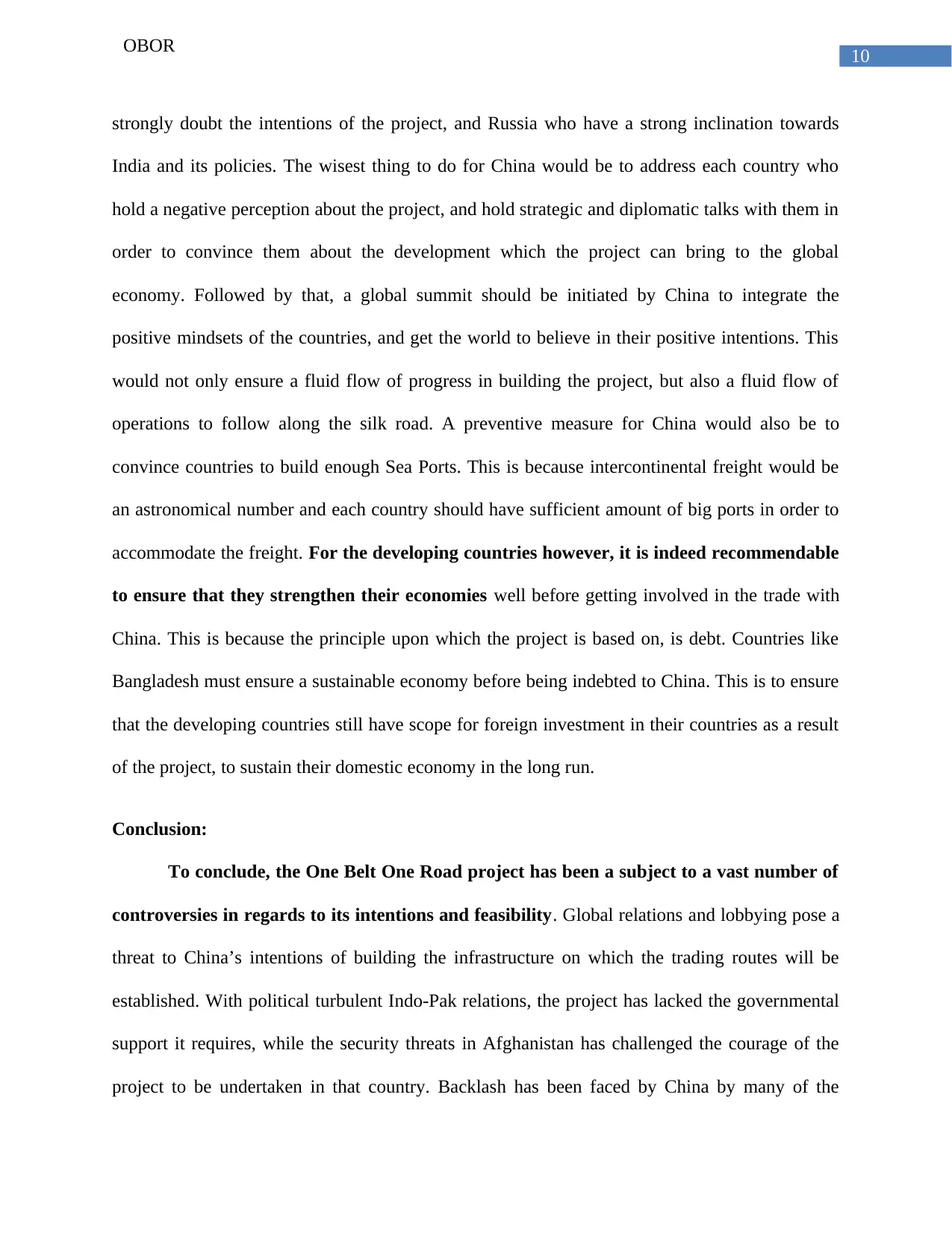
10
OBOR
strongly doubt the intentions of the project, and Russia who have a strong inclination towards
India and its policies. The wisest thing to do for China would be to address each country who
hold a negative perception about the project, and hold strategic and diplomatic talks with them in
order to convince them about the development which the project can bring to the global
economy. Followed by that, a global summit should be initiated by China to integrate the
positive mindsets of the countries, and get the world to believe in their positive intentions. This
would not only ensure a fluid flow of progress in building the project, but also a fluid flow of
operations to follow along the silk road. A preventive measure for China would also be to
convince countries to build enough Sea Ports. This is because intercontinental freight would be
an astronomical number and each country should have sufficient amount of big ports in order to
accommodate the freight. For the developing countries however, it is indeed recommendable
to ensure that they strengthen their economies well before getting involved in the trade with
China. This is because the principle upon which the project is based on, is debt. Countries like
Bangladesh must ensure a sustainable economy before being indebted to China. This is to ensure
that the developing countries still have scope for foreign investment in their countries as a result
of the project, to sustain their domestic economy in the long run.
Conclusion:
To conclude, the One Belt One Road project has been a subject to a vast number of
controversies in regards to its intentions and feasibility. Global relations and lobbying pose a
threat to China’s intentions of building the infrastructure on which the trading routes will be
established. With political turbulent Indo-Pak relations, the project has lacked the governmental
support it requires, while the security threats in Afghanistan has challenged the courage of the
project to be undertaken in that country. Backlash has been faced by China by many of the
OBOR
strongly doubt the intentions of the project, and Russia who have a strong inclination towards
India and its policies. The wisest thing to do for China would be to address each country who
hold a negative perception about the project, and hold strategic and diplomatic talks with them in
order to convince them about the development which the project can bring to the global
economy. Followed by that, a global summit should be initiated by China to integrate the
positive mindsets of the countries, and get the world to believe in their positive intentions. This
would not only ensure a fluid flow of progress in building the project, but also a fluid flow of
operations to follow along the silk road. A preventive measure for China would also be to
convince countries to build enough Sea Ports. This is because intercontinental freight would be
an astronomical number and each country should have sufficient amount of big ports in order to
accommodate the freight. For the developing countries however, it is indeed recommendable
to ensure that they strengthen their economies well before getting involved in the trade with
China. This is because the principle upon which the project is based on, is debt. Countries like
Bangladesh must ensure a sustainable economy before being indebted to China. This is to ensure
that the developing countries still have scope for foreign investment in their countries as a result
of the project, to sustain their domestic economy in the long run.
Conclusion:
To conclude, the One Belt One Road project has been a subject to a vast number of
controversies in regards to its intentions and feasibility. Global relations and lobbying pose a
threat to China’s intentions of building the infrastructure on which the trading routes will be
established. With political turbulent Indo-Pak relations, the project has lacked the governmental
support it requires, while the security threats in Afghanistan has challenged the courage of the
project to be undertaken in that country. Backlash has been faced by China by many of the
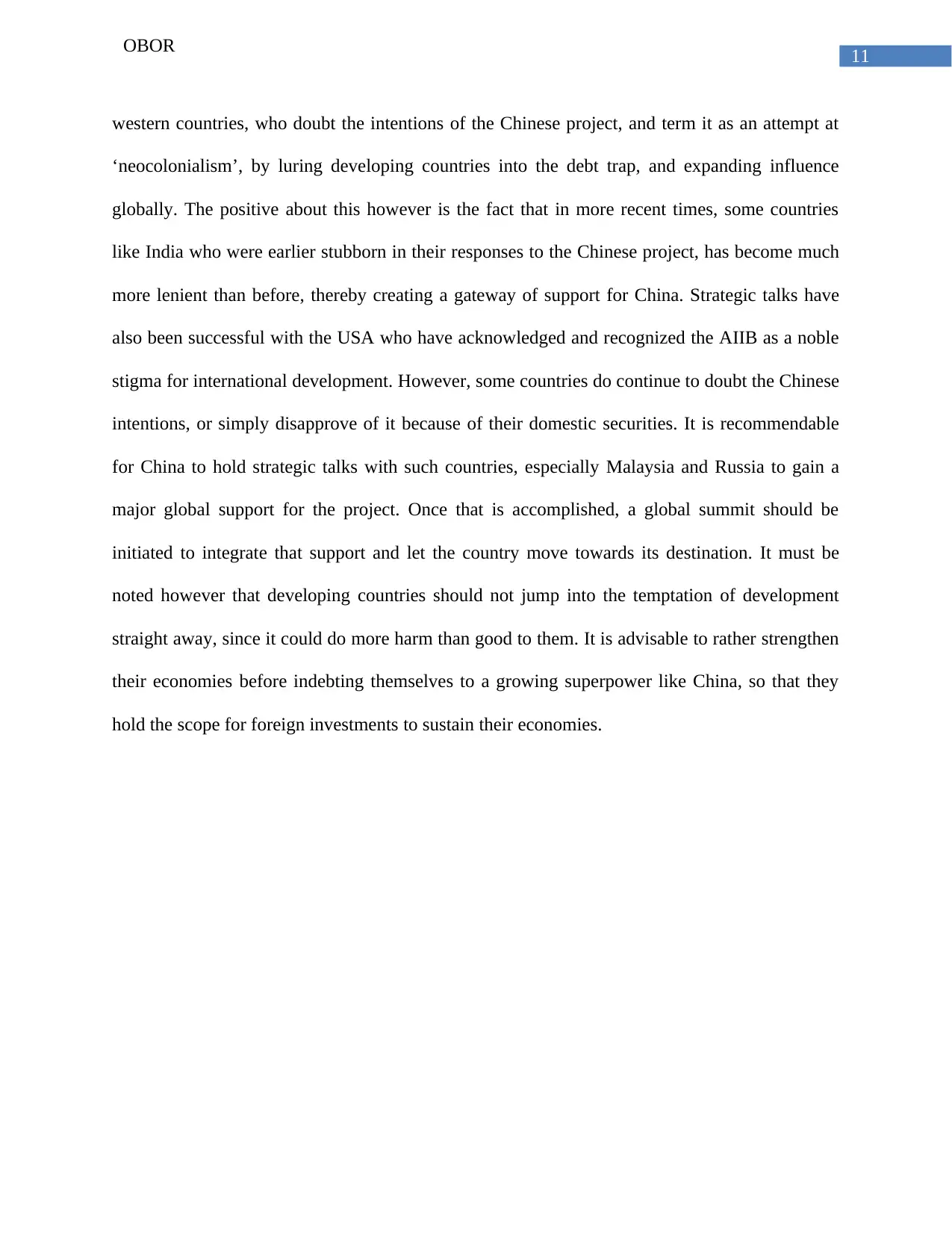
11
OBOR
western countries, who doubt the intentions of the Chinese project, and term it as an attempt at
‘neocolonialism’, by luring developing countries into the debt trap, and expanding influence
globally. The positive about this however is the fact that in more recent times, some countries
like India who were earlier stubborn in their responses to the Chinese project, has become much
more lenient than before, thereby creating a gateway of support for China. Strategic talks have
also been successful with the USA who have acknowledged and recognized the AIIB as a noble
stigma for international development. However, some countries do continue to doubt the Chinese
intentions, or simply disapprove of it because of their domestic securities. It is recommendable
for China to hold strategic talks with such countries, especially Malaysia and Russia to gain a
major global support for the project. Once that is accomplished, a global summit should be
initiated to integrate that support and let the country move towards its destination. It must be
noted however that developing countries should not jump into the temptation of development
straight away, since it could do more harm than good to them. It is advisable to rather strengthen
their economies before indebting themselves to a growing superpower like China, so that they
hold the scope for foreign investments to sustain their economies.
OBOR
western countries, who doubt the intentions of the Chinese project, and term it as an attempt at
‘neocolonialism’, by luring developing countries into the debt trap, and expanding influence
globally. The positive about this however is the fact that in more recent times, some countries
like India who were earlier stubborn in their responses to the Chinese project, has become much
more lenient than before, thereby creating a gateway of support for China. Strategic talks have
also been successful with the USA who have acknowledged and recognized the AIIB as a noble
stigma for international development. However, some countries do continue to doubt the Chinese
intentions, or simply disapprove of it because of their domestic securities. It is recommendable
for China to hold strategic talks with such countries, especially Malaysia and Russia to gain a
major global support for the project. Once that is accomplished, a global summit should be
initiated to integrate that support and let the country move towards its destination. It must be
noted however that developing countries should not jump into the temptation of development
straight away, since it could do more harm than good to them. It is advisable to rather strengthen
their economies before indebting themselves to a growing superpower like China, so that they
hold the scope for foreign investments to sustain their economies.
⊘ This is a preview!⊘
Do you want full access?
Subscribe today to unlock all pages.

Trusted by 1+ million students worldwide
1 out of 16
Related Documents
Your All-in-One AI-Powered Toolkit for Academic Success.
+13062052269
info@desklib.com
Available 24*7 on WhatsApp / Email
![[object Object]](/_next/static/media/star-bottom.7253800d.svg)
Unlock your academic potential
Copyright © 2020–2025 A2Z Services. All Rights Reserved. Developed and managed by ZUCOL.





